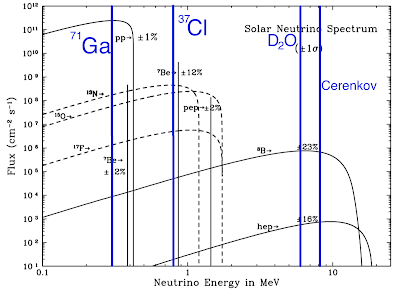Neutrino Astrophysics: Detectors
, 4 min, 643 words
Tags: physics neutrinos astrophysics
Neutrino detection is a tricky enterprise in the best of cases. Since neutrinos interact only via the weak interaction, their interactions have fantastically low cross-sections, which means that detectors end up seeing only a couple of neutrinos per day in some of the better cases.
The very first neutrino detector is typically called the Homestake or Davis experiment, and involved ${}^{37}$Cl in the form of perchloroethylene, a common cleaning chemical. The interaction monitored by the experiment was $\nu_e+{}^{37}\text{Cl}\rightarrow e^- + {}^{37}\text{Ar}$. For those of you without a periodic table handy, this is just the conversion of a neutron in chlorine to a proton in argon. The lowest-energy neutrinos that could participate in this reaction had energies of around 0.8 MeV. Luckily for science, the results of the experiment were interesting enough to warrant a new generation of detectors, based on gallium-71.
Gallium detectors monitor the reaction $\nu_e+{}^{71}\text{Ga}\rightarrow e^- + {}^{71}\text{Ge}$, but have a much lower threshold energy: just 0.2 MeV, which is low enough to detect pp chain neutrinos. Oh, and another fun fact: one of the gallium neutrino detectors contained 60 tons of gallium, at a time when the world production of gallium was just 10 tons per year! The threshold energies for these detector types are shown in the figure below. Both of these experiment types are chemically based: physicists set up the detectors, leave them alone for a couple of months, then chemically separate out the desired atoms, and somehow count them one by one. While these can detect solar neutrinos, this experimental model has some drawbacks: it can't tell you exactly when an interaction occurred, and it gives little to no information about the direction or energy of the incoming neutrino. These drawbacks led to the next generation of neutrino detection: Cerenkov detectors.
The first Cerenkov detectors looked for elastic scattering between neutrinos and electrons. In such a process, the electron may be accelerated to faster than the speed of light in the detector medium (water or ice). When this occurs, Cerenkov radiation is emitted as the electron decelerates. This is the source of that beautifully toxic blue you see around nuclear waste in underwater facilities. The basic structure for a Cerenkov detector is a huge tank of water (or a cubic kilometer of Antarctic ice, in the case of Ice Cube) for neutrinos to interact with, surrounded by hundreds or thousands of photomultiplier tubes to detect the Cerenkov radiation. Elastic scattering of neutrinos and electrons requires fairly high-energy neutrinos (around 7 MeV), so it can't detect the pp chain neutrinos that gallium detectors can, but it has the advantages of time resolution and directional resolution, since Cerenkov radiation is produced in a cone around the accelerated electron. Note that the neutrinos that scatter with electrons are primarily electron neutrinos, though small fractions of the interactions can involve the other flavors.
Based on this idea is a fourth detector, the Sudbury Solar Neutrino Observatory (SNO). It is a Cerenkov detector with heavy water, which contains a lot of deuterium, instead of the normal old hydrogen. The beauty of this detector is that it's sensitive to two reactions: $\nu_e+D\rightarrow e^-+p+p$, which only detects electron neutrinos, and $\nu+D\rightarrow \nu'+n+p$, which can detect all three flavors of electrons. This ability will turn out to be very beneficial in the resolution of the solar neutrino problem.

This is the second post in a series on neutrino astrophysics. Other neutrino-related posts can be found here.